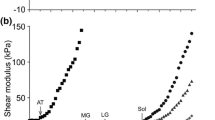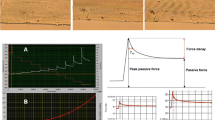Abstract
Measuring viscoelastic stress-relaxation (VSR) as the decline in passive tension over time when the skeletal muscle-tendon unit (MTU) is held in a lengthened position may be difficult in older people who may have difficulty relaxing. This study examined the VSR of the aged calf MTUs with a low-level involuntary contractile response from the soleus (S), gastrocnemius (G) and tibialis anterior (TA) muscles. Calf MTUs of 29 men and women (65–90 years) were stretched to maximal dorsiflexion and held for 60 s while torque (Nm) and surface electromyograms (SEMG) were recorded. Subjects with normalized SEMG (% of maximal voluntary contraction SEMG) of the S, G or TA <1% were assigned to Group 1 (n=14) and subjects with SEMG of the S or G ≥1% and <10%, or in the TA ≥1% were assigned to Group 2 (n=15). Although the mean total percent torque decline for Group 1 (17.9%) and Group 2 (16.6%) did not differ statistically, multiple regression analysis within Group 2 indicated that the G and TA SEMG accounted for 58% of its variation (R 2=0.581). The G SEMG from 0–15 s accounted for 56% (r 2=0.563) of the variation in the percent decline normalized to total percent decline (100%). From 15–30 s Group 2 had less percent decline (2%) than Group 1 (14%) (P=0.043) and the S and G SEMG accounted for 67% of its variation (R 2=0.673). The results indicated that a low-level involuntary contractile response from the S, G and TA muscles may be related to the VSR process of aged calf MTUs. Measuring VSR within time intervals normalized to the total percent decline offers a new method to study VSR, which should be measured with SEMG in the muscles <1% MVC SEMG to ensure valid measurements.







Similar content being viewed by others
References
Alnaqeeb MA, Al Zaid NS, Goldspink G (1984) Connective tissue changes and physical properties of developing and ageing skeletal muscle. J Anat 139:677–689
Blanpied P, Smidt GL (1992) Human plantarflexor stiffness to multiple single-stretch trials. J Biomechanics 25:29–39
Gajdosik RL (2001) Passive extensibility of skeletal muscle: review of the literature with clinical implications. Clin Biomech 16:87–101
Gajdosik RL, Vander Linden DW, Williams AK (1996) Influence of age on concentric isokinetic torque and passive extensibility variables of the calf muscles of women. Eur J Appl Physiol 74:279–286
Gajdosik RL, Vander Linden DW, Williams AK (1999) Influence of age on length and passive elastic stiffness characteristics of the calf muscle-tendon unit of women. Phys Ther 79:827–838
Gajdosik RL, Vander Linden DW, McNair PJ, Riggin RJ, Albertson JS, Mattick DJ, Wegley JC (2004) Slow passive stretch and release characteristics of the calf muscles of older women with limited dorsiflexion range of motion. Clin Biomech 19(4):398–406
Hermens HJ, Freriks B, Disselhorst-Klug C, Rau G (2000) Development of recommendations for SEMG sensors and sensor placement procedures. J Electromyogr Kinesiol 10:361–374
Huijing PA, Ettema GJC (1988) Length-force characteristics of aponeurosis in passive muscle and during isometric and slow dynamic contractions of rat gastrocnemius muscle. Acta Morphol Neerl-Scand 26:51–62
Klinge K, Magnusson SP, Simonsen EB, Aagaard P, Klausen K, Kjaer M (1997) The effects of strength and flexibility training on skeletal muscle electromyographic activity, stiffness, and viscoelastic stress relaxation. Am J Sports Med 25:710–716
Kovanen V (1989) Effects of ageing and physical training on rat skeletal muscle. An experimental study on the properties of collagen, laminin, and fibre types in muscles serving different functions. Acta Physiol Scand Suppl 577:1–56
Kovanen V, Suominen H (1988) Effects of age and life-long endurance training on the passive mechanical properties of rat skeletal muscle. Compr Gerontol A 2:18–23
Kurokawa S, Fukunaga T, Nagano A, Fukashiro S (2003) Interaction between fascicles and tendinous structures during counter movement jumping investigated in vivo 95:2306–2314
Lamontagne A, Malouin F, Richards C L (1997) Viscoelastic behavior of plantar flexor muscle-tendon unit at rest. J Orthop Sports Phys Ther 26(5):244–252
Le Veau BF (1992) In: Williams and Lissner’s biomechanics of human motion, 3rd edn. W. B. Saunders, Philadelphia, pp 33–37
Magnusson SP, Aagaard P, Simonsen EB, Bojsen-Moller F (1998) A biomechanical evaluation of cyclic and static stretch in human skeletal muscle. Int J Sports Med 19:310–316
Magnusson SP, Aagaard P, Simonsen EB, Bojsen-Moller F (2000) Passive tensile stress and energy of the human hamstring muscles in-vivo. Scand J Med Sci Sports 10:351–359
Magnusson SP, Simonsen EB, Aagaard P, Boesen J, Johannsen F, Kjaer M (1997) Determinants of musculoskeletal flexibility: viscoelastic properties, cross-sectional area, EMG and stretch tolerance. Scand J Med Sci Sports 7:195–202
Magnusson SP, Simonsen EB, Aagaard P, Dyhre-Poulsen P, McHugh MP, Kjaer M (1996a) Mechanical and physiological responses to stretching with and without preisometric contraction in human skeletal muscle. Arch Phys Med Rehabil 77:373–378
Magnusson SP, Simonsen EB, Aagaard P, Gleim GW, McHugh MP, Kjaer M (1995a) Viscoelastic response to repeated static stretching in human hamstring muscle. Scand J Med Sci Sports 5:342–347
Magnusson SP, Simonsen EB, Aagaard P, Moritz U, Kjaer M (1995b) Contraction specific changes in passive torque in human skeletal muscle. Acta Physiol Scand 155:377–386
Magnusson SP, Simonsen EB, Aagaard P, Sorensen H, Kjaer M (1996c) A mechanism for altered flexibility in human skeletal muscle. J Physiol 497.1:291–298
Magnusson SP, Simonsen EB, Dyhre-Poulsen P, Aagaard P, Mohr T, Kjaer M (1996b) Viscoelastic stress relaxation during static stretch in human skeletal muscle in the absence of EMG activity. Scand J Med Sci Sports 6:323–328
McHugh MP, Magnusson SP, Gleim GW, Nicholas JA (1992) Viscoelastic stress relaxation in human skeletal muscle. Med Sci Sport Exerc 24(12):1375–1382
McNair PJ, Dombroski EW, Hewson DJ, Stanley SN (2001) Stretching at the ankle joint: viscoelastic responses to holds and continuous passive motion. Med Sci Sport Exerc 33:354–358
Moore MA, Hutton RS (1980) Electromyographic investigation of muscle stretching techniques. Med Sci Sport Exerc 12:322–329
Osternig LR, Robertson R, Troxel R, Hansen P (1987) Muscle activation during proprioceptive neuromuscular facilitation (PNF) stretching techniques. Am J Phys Med 66:298–307
Osternig LR, Robertson RN, Troxel RK, Hansen P (1990) Differential responses to proprioceptive neuromuscular facilitation (PNF) stretch techniques. Med Sci Sport Exerc 22:106–111
Purslow PP (1989) Strain-induced reorientation of an intramuscular connective tissue network: Implications for passive muscle elasticity. J Biomech 22(1):21–31
Purslow PP, Wess TJ, Hukins DWL (1998) Collagen orientation and molecular spacing during creep and stress-relaxation in soft connective tissues. J Exp Biol 201:135–142
Simons DG, Mense S (1998) Understanding and measurement of muscle tone as related to clinical muscle pain. Pain 75:1–17
Singer BJ, Dunne JW, Singer KP, Allison GT (2003) Velocity dependent passive plantarflexor resistive torque in patients with acquired brain injury. Clin Biomech 18:157–165
Taylor DC, Dayton JD, Seaber AV, Garrett WE (1990) Viscoelastic properties of muscle-tendon units. The biomechanical effects of stretching. Am J Sports Med 18(3):300–308
Trombitas K, Greaser M, Labeit S, Jin J-P, Kellermayer M, Helmes M, Granzier H (1998) Titin extensibility in situ: entropic elasticity of permanently folded and permanently unfolded molecular segments. J Cell Biol 140:853–859
Tskhovrebova L, Trinick J, Sleep JA, Simmons RM (1997) Elasticity and unfolding of single molecules of the giant muscle protein titin. Nature 387:308–312
Wang K, McCarter R, Wright J, Beverly J, Ramirez-Mitchell R (1993) Viscoelasticity of the sarcomere matrix of skeletal muscles: the titin-myosin composite filament is a dual-stage molecular spring. Biophys J 64:1161–1177
Wang K, Ramirez-Mitchell R (1983) A network of transverse and longitudinal intermediate filaments is associated with sarcomeres of adult vertebrate muscle. J Cell Biol 96:562–570
Zuurbier CJ, Everard AJ, van der Wees P, Juijing PA (1994) Length-force characteristics of the aponeurosis in the passive and active muscle condition and in the isolated condition. J Biomech 27:445–453
Acknowledgements
This study was partially funded by The National Institutes of Health (NIH) Grant No. R24 HD39629-04 through RehabNet˜West, The University of Washington, Seattle, WA, and grants from The MJ Murdock Charitable Trust Foundation and The University of Montana (USA). Special appreciation is extended to Sheng Li, PhD, Assistant Professor, The School of Physical Therapy and Rehabilitation Science, The University of Montana, for his help with the data reduction. The experiments in this study complied with the current laws of the United States of America.
Author information
Authors and Affiliations
Corresponding author
Rights and permissions
About this article
Cite this article
Gajdosik, R.L. Influence of a low-level contractile response from the soleus, gastrocnemius and tibialis anterior muscles on viscoelastic stress-relaxation of aged human calf muscle-tendon units. Eur J Appl Physiol 96, 379–388 (2006). https://doi.org/10.1007/s00421-005-0091-7
Accepted:
Published:
Issue Date:
DOI: https://doi.org/10.1007/s00421-005-0091-7




